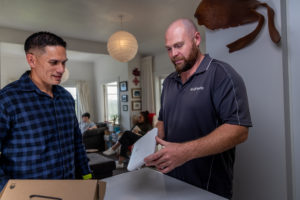Sometimes you don’t even have to be living in a particularly remote location to miss out on fibre. It may be that someone down your road has it (which happens more often than you think), but it isn’t available at your home, which hardly seems fair.
So, how do we make sense of how addresses are selected for fibre access? We first need to understand the Ultrafast Broadband (UFB) rollout.
In 2011, the NZ Government, through Crown Infrastructure Partners, awarded funding to 4 companies to roll out fibre to 75% of NZ households. In the Waikato and Bay of Plenty regions, Tuatahi First Fibre (formerly UFF) got the bulk of the funding. However, Chorus did secure small pockets, such as the area around Hamilton Airport.
The Government awarded funding for specific areas, which meant that the fibre companies built to the addresses that were covered under the program and no further. This is why some addresses on town fringes ended up not having access to fibre.
Annoying, I know.
However, in early 2017, the Government expanded the original UFB programme to include additional areas. This second phase of the UFB rollout, called UFB2, means that 85% of New Zealanders will have fibre access by the end of 2022. This initiative will extend the reach of the fibre network in New Zealand by 10%.
So, that’s the first determining factor – which addresses were covered by the Government’s UFB initiative.
If fibre is near me, why can’t they just run it a little further and get me connected?
That’s where the second factor comes in. That being the cost of putting fibre into the ground, which we call “trenching”. The cost of digging up the dirt to the required depth and width, placing the fibre in the ground and sealing it safely, has typically cost about $100 p/metre.
This means that for an address just down the road from where a fibre zone ends, the owners may be able to pay a relatively small amount to have the fibre extended to their house, while those living more remotely will find the installation cost prohibitive. I mean, we’ve had quotes come back at $200,000+ where more than 2km of trenching was required.
The reality of the fibre deployment
We can see why it’s been deployed the way it has. Fibre is best suited to areas that are densely populated so that the cost of building the network can be spread across a greater number of connections.
Because of this requirement, 15% of NZ households are unlikely to ever get access to fibre. That’s almost 279, 800 homes. But for the people living in those homes, there is still some good news, there are other technologies that will enable you to access fast, reliable internet.
Do more with fixed wireless
That’s where organisations like Lightwire come in, providing fibre like speeds via fixed wireless to make sure that you can do more while living rural. We do this by having gone of our team install a dish on your roof that will receive a signal from a Lightwire tower on a nearby hill. Radio signals will be beamed across a clear Line of Sight (LoS) between the tower and your dish, over which data is carried.
Lightwire’s residential network is 100% owned and operated by Lightwire, meaning that we can control the contention policies end to end. By definition, all residential networks will run with some level of contention, but where many RBI 4G towers (the towers that Vodafone, Spark and other big players provide services from) can be heavily congested and provide poor speeds, Lightwire works hard and continually pumps money into the network to keep growing capacity.
If you’re keen to learn more about fixed wireless, you can read about it here!


